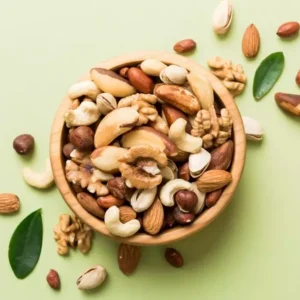Tyrosine is a non-essential amino acid (component of proteins) that can be synthesized by the body. However, tyrosine is also found in foods rich in protein or in the form of food supplements suitable for athletes.
Characteristics of tyrosine:
- Non-essential but important amino acid for the body
- Participates in the synthesis of numerous neurotransmitters
- Found mainly in products of animal origin and oilseeds
- L-tyrosine supplements are widely used by athletes and to combat fatigue.
- Antioxidant action that slows down cellular aging
Why consume foods rich in tyrosine?
Benefits and roles of tyrosine
Hormonal synthesis
Tyrosine is involved in the synthesis of adrenaline and norepinephrine but also of melanin (skin and hair pigment) and thyroid hormones.
Anti-oxidant
Tyrosine has an anti-oxidant action which helps limit cellular aging.
Anti-fatigue and anti-stress
In the event of intense physical activity, tyrosine supplementation can be considered in order to stimulate dopamine production and achieve better recovery.
20 foods rich in tyrosine
The food composition table does not specify tyrosine contents, however the list below lists the richest foods.
- Lait
- Egg
- Meat
- Poisson
- Nut
- Cashew nuts
- Almond
- Lawyer
- Mushroom
- Green bean
- Potato
- Aubergine
- Beet
- Radish
- Asparagus
- Parsley
- Cucumber
- Red onion
- Spinach
- Rye
 Receive every day
Receive every day
advice from our experts
to take care of you

Use of tyrosine
The daily requirement is estimated at 1 to 2 grams of tyrosine for a healthy adult.
Tyrosine supplements: opinions and contraindications
L-tyrosine food supplements are generally prescribed to promote mental awareness and energy, particularly in athletes. They help effectively combat physical and mental fatigue. Regarding tyrosine supplementation, the dosage is often 500 mg of L-tyrosine per day, preferably taken in the first part of the day when the synthesis of neurotransmitters in the brain reaches a peak.
Tyrosine kinase inhibitors, on the other hand, are often used to slow tumor growth in the body. these inhibitors block the growth of tyrosine kinase which is an enzyme directly involved in the development and growth of atypical cells.
Side effects of tyrosine
Is tyrosine deficiency a health hazard?
Tyrosine is mainly synthesized by the body, however it can happen that it is synthesized in insufficient quantities. In these situations, significant fatigue and low resistance to stress are noted.
Consequence of excess tyrosine
The scientific literature does not report excess tyrosine.
Tyrosine and Parkinson’s disease
Tyrosine as a dietary supplement is strongly not recommended in people being treated for dopaminergic disorders such as Parkinson’s disease.
In addition, tyrosine in high doses can interact with the action of thyroid hormones, in the event of pathology of the thyroid gland it is therefore advisable to consult a doctor before taking L-tyrosine.
Chemical properties
The crude formula of tyrosine is C9H11NO3, its molar mass is 181.1885 g/mol. Tyrosine is a so-called non-essential amino acid for the human body. Indeed, we know how to synthesize it. However, it can be produced in insufficient quantities, hence the need to provide enough through food.
Tyrosine is characterized by its phenol group, the hydroxyl of which is acidic. This amino acid is synthesized from phenylalanine. It has a very important role since it participates in the synthesis of many essential substances: dopamine, norepinephrine, adrenaline, etc. In addition, it is a precursor of thyroid hormones and melanin.
Historical
Nutrient History
An amino acid with many roles in the body, tyrosine was also for a long time a molecule of choice for the treatment of certain conditions. Indeed, several patents have been obtained for the use of tyrosine in a therapeutic context and in particular to treat depression, Parkinson’s disease and even shock states.
Even today, the combination of DOPA and tyrosine is used to treat certain attention disorders such as hyperactivity.

Dietitian Nutritionist
September 2017

Dietitian Nutritionist
July 2018
95% Readers found this article helpful And you ?
Was this article useful to you?













